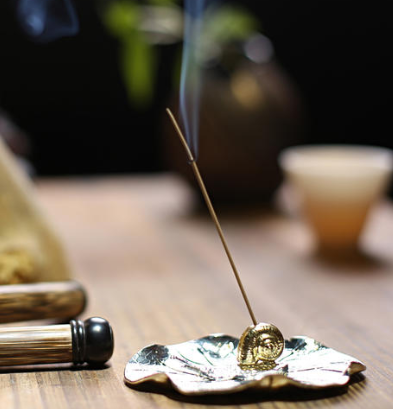The incense factory teaches you how to distinguish quality
1、 Touch sensation
From the tactile sensation of incense ash, it can actually distinguish whether agarwood incense is natural or not.
A section of incense ash that has just been burned off the agarwood incense stick is bounced onto the back of the hand. If there is severe pain, it indicates that there is a chemical accelerant in the agarwood incense stick, which cannot burn during the burning process of the incense stick. The temperature is preserved, and incense sticks bonded with glue generally produce this appearance more easily; If there is a noticeable residual temperature, i.e. residual temperature, but no severe stinging sensation, it indicates that there may be incremental materials such as limestone in the fragrance; If there is no sensation in the hand, such as the feeling of fuzz, it indicates that there are no additives in the fragrance except for the natural formula. Because of its natural fragrance, only two things are needed, natural fragrance powder and natural adhesive powder, made according to the proportion. From a common sense perspective, the fragrance produced in this way burns fully without any temperature residue.
2、 Color
In terms of the color of agarwood, generally speaking, the color of agarwood with good grades is black, but it does not necessarily mean that agarwood with high grades is black.
Because fragrant gray black indicates a high amount of oil, the relative grade will also be relatively high. But there may be doubts about discrimination because some fragrance enthusiasts do not like the ash to be black in the furnace, like caterpillars one by one. Therefore, some fragrance masters will participate in a small amount of charcoal during the blending process, which will make the ash turn white. Of course, since the ash black level is already high, they can naturally participate in other things to make the ash black. So it cannot be concluded that the quality of agarwood is necessarily good just because it is fragrant gray black, and fragrant gray white is not necessarily of poor grade.

3、 Shape
In terms of the shape of incense ash, there are two types of shapes after combustion: one is broken in sections, and the other is broken and continuous, such as standing upright and rolling. It is difficult to distinguish the unevenness of agarwood quality from its shape, as it is caused by multiple factors.
One is the environmental impact of burning agarwood incense, as humidity and temperature in the air can affect whether the incense will curl.
The second factor is the kneading density of the injection during the production of incense, which will have a certain impact on the combustion shape after all.
The third is the origin and oil content of the incense material. According to the records, Huian style incense generally does not break during the combustion process. Vietnam's red soil and Nha Trang are typical examples of soil settling. After high-temperature combustion, the soil particles contained in the settling will undergo pottery transformation, making the ash hard and unable to stand upright. In humid spring and summer, it will bend and form large rolls.
Article source: Incense manufacturerhttp://www.dongfangxl.com/
-
09-30
What are the structures of bamboo stick incense?
Bamboo stick incense, also known as string incense, stick incense, or standing incense in Taiwan, and bamboo stick incense in mainland China, is named after its use of bamboo branches, cinnamon bamboo
-
09-30
Incense Manufacturer: Craftsmanship for Making Bamboo Stick Incense
The ancients discovered that any type of spice has the effects of refreshing and calming the mind, so the history of incense burning in China has been over 3000 years, and China can be considered one
-
09-08
Fragrant powder and spice factory: production techniques for bamboo stick fragrance
Nowadays, when making bamboo stick incense, the following methods should be used first:1. Traditional craftsmanship involves hand pouring fragrance.2. Handmade powder coating and mechanical bucket mak
-
08-26
Fragrant powder and spice factory: How to distinguish the quality of bamboo stick fragrance?
We call fragrances made from natural spices "natural fragrances", fragrances with artificially synthesized spices "chemical fragrances", or perhaps "fragrance crafts". Chemical fragrance only has the
